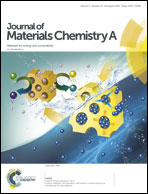Rapid water transport through controllable, ultrathin polyamide nanofilms for high-performance nanofiltration†
Abstract
Various attempts are increasingly being made to decrease the thickness of polyamide (PA) nanofilms, in order to promote water transport. Despite optimization of interfacial polymerization (IP), it is challenging to prepare defect-free, ultrathin nanofilms in situ on top of membrane substrates. This issue is closely linked to the rapid, uncontrolled IP reaction, and the physicochemical properties of support materials. In this study, PA nanofilms less than 12 nm in thickness were fabricated at a free water–hexane interface, followed by directly transferring them onto polydopamine (PDA) coated polymer substrates via vacuum filtration. This method not only efficaciously controls the nanofilm thickness, but also largely reduces the monomer content compared to a traditional IP process. Manipulation of nanofilm thickness and structure through fine-tuning the monomer concentration enables the formation of smooth, ultrathin, and robust PA layers. Composite membranes with polypiperazine amide nanofilms exhibit a high water permeance (25.1 L m−2 h−1 bar−1), and an excellent divalent salt rejection (RNa2SO4 = 99.1%). This more than doubles the permeance of a commercial nanofiltration (NF) membrane, although the Na2SO4 retention is generally below 98.5%. Importantly, the low NaCl retention endows the nanofilm composite membranes with a high mono/divalent salt selectivity (80.6). This facile, one-pot strategy provides a useful guideline for the construction of highly permeable TFC membranes for water purification.



 Please wait while we load your content...
Please wait while we load your content...